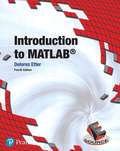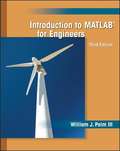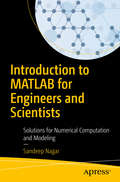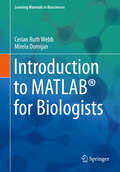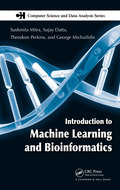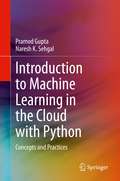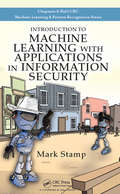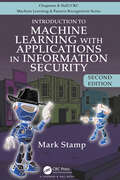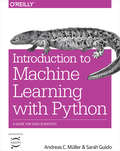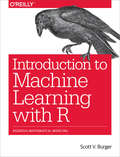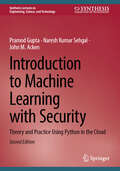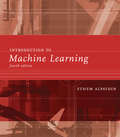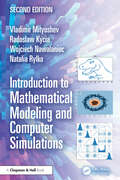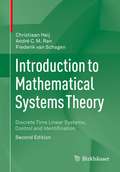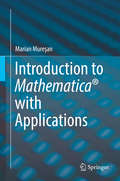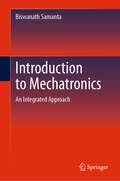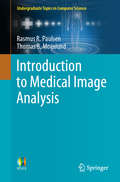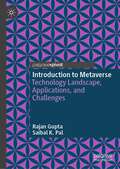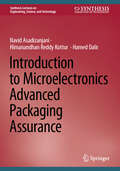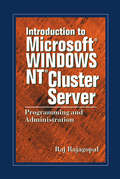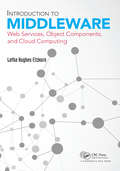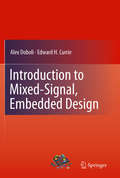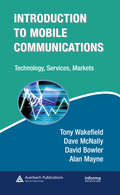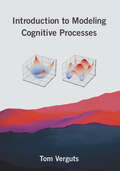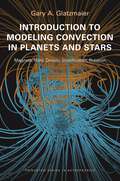- Table View
- List View
Introduction to MATLAB
by Delores EtterThis book is appropriate for use as an introductory engineering text or as a supplemental text in an advanced course. It is also useful as a professional reference. The text will introduce engineering problem solving with the following objectives: (i) Present a consistent methodology for solving engineering problems; (ii) Describe the exceptional computational and visualization capabilities of MATLAB; and (iii) Illustrate the problem-solving process through a variety of engineering examples and applications. Throughout the text, emphasis is placed on incorporating real-world engineering and scientific examples with solutions and usable code. Each chapter ends with a Summary that reviews the topics covered and includes a list of Key Terms. A MATLAB Summary lists all the special symbols, commands, and functions defined in the chapter. Hints are provided to help the student avoid some of the common errors.
Introduction to MATLAB for Engineers
by William J. PalmIntroduction to MATLAB for Engineersis a simple, concise book designed to be useful for beginners and to be kept as a reference. The terminology, syntax, and the use of the programming language are well defined, and the organization of the material makes it easy to locate information and navigate through the textbook. The text covers all the major capabilities of MATLAB that are useful for beginning students.
Introduction to MATLAB for Engineers and Scientists
by Sandeep NagarFamiliarize yourself with MATLAB using this concise, practical tutorial that is focused on writing code to learn concepts. Starting from the basics, this book covers array-based computing, plotting and working with files, numerical computation formalism, and the primary concepts of approximations. Introduction to MATLAB is useful for industry engineers, researchers, and students who are looking for open-source solutions for numerical computation. In this book you will learn by doing, avoiding technical jargon, which makes the concepts easy to learn. First you'll see how to run basic calculations, absorbing technical complexities incrementally as you progress toward advanced topics. Throughout, the language is kept simple to ensure that readers at all levels can grasp the concepts. What You'll Learn Apply sample code to your engineering or science problems Work with MATLAB arrays, functions, and loops Use MATLAB's plotting functions for data visualization Solve numerical computing and computational engineering problems with a MATLAB case study Who This Book Is For Engineers, scientists, researchers, and students who are new to MATLAB. Some prior programming experience would be helpful but not required.
Introduction to MATLAB® for Biologists (Learning Materials in Biosciences)
by Cerian Ruth Webb Mirela DomijanThis textbook takes you from the very first time you open MATLAB® through to a position where you can comfortably integrate this computer language into your research or studies. The book will familiarise you with the MATLAB interface, show you how to use the program´s built-in functions and carefully guide you towards creating your own functions and scripts so that you can use MATLAB as a sophisticated tool to support your own research. A central aim of this book is to provide you with the core knowledge and skills required to become a confident MATLAB user so that you can find and make use of the many specialist functions and toolboxes that have been developed to support a wide range of biological applications. Examples presented within the book are selected to be relevant to biological scientists and they illustrate some of the many ways the program can be incorporated into, and used to enhance, your own research and studies. The textbook is a must-have for students and researchers in the biological sciences. It will also appeal to readers of all backgrounds who are looking for an introduction to MATLAB which is suitable for those with little or no experience of programming.
Introduction to Machine Learning and Bioinformatics
by Sushmita Mitra Sujay Datta Theodore Perkins George MichailidisLucidly Integrates Current ActivitiesFocusing on both fundamentals and recent advances, Introduction to Machine Learning and Bioinformatics presents an informative and accessible account of the ways in which these two increasingly intertwined areas relate to each other. Examines Connections between Machine Learning & Bio
Introduction to Machine Learning in the Cloud with Python: Concepts and Practices
by Pramod Gupta Naresh K. SehgalThis book provides an introduction to machine learning and cloud computing, both from a conceptual level, along with their usage with underlying infrastructure. The authors emphasize fundamentals and best practices for using AI and ML in a dynamic infrastructure with cloud computing and high security, preparing readers to select and make use of appropriate techniques. Important topics are demonstrated using real applications and case studies.
Introduction to Machine Learning with Applications in Information Security
by Mark Stamp<p>Introduction to Machine Learning with Applications in Information Security provides a class-tested introduction to a wide variety of machine learning algorithms, reinforced through realistic applications. The book is accessible and doesn’t prove theorems, or otherwise dwell on mathematical theory. The goal is to present topics at an intuitive level, with just enough detail to clarify the underlying concepts. <p>The book covers core machine learning topics in-depth, including Hidden Markov Models, Principal Component Analysis, Support Vector Machines, and Clustering. It also includes coverage of Nearest Neighbors, Neural Networks, Boosting and AdaBoost, Random Forests, Linear Discriminant Analysis, Vector Quantization, Naive Bayes, Regression Analysis, Conditional Random Fields, and Data Analysis. <p>Most of the examples in the book are drawn from the field of information security, with many of the machine learning applications specifically focused on malware. The applications presented are designed to demystify machine learning techniques by providing straightforward scenarios. Many of the exercises in this book require some programming, and basic computing concepts are assumed in a few of the application sections. However, anyone with a modest amount of programming experience should have no trouble with this aspect of the book. <p>Instructor resources, including PowerPoint slides, lecture videos, and other relevant material are provided on an accompanying website: http://www.cs.sjsu.edu/~stamp/ML/. For the reader’s benefit, the figures in the book are also available in electronic form, and in color.
Introduction to Machine Learning with Applications in Information Security (Chapman And Hall/crc Machine Learning And Pattern Recognition Ser.)
by Mark StampIntroduction to Machine Learning with Applications in Information Security, Second Edition provides a classroom-tested introduction to a wide variety of machine learning and deep learning algorithms and techniques, reinforced via realistic applications. The book is accessible and doesn’t prove theorems, or dwell on mathematical theory. The goal is to present topics at an intuitive level, with just enough detail to clarify the underlying concepts. The book covers core classic machine learning topics in depth, including Hidden Markov Models (HMM), Support Vector Machines (SVM), and clustering. Additional machine learning topics include k-Nearest Neighbor (k-NN), boosting, Random Forests, and Linear Discriminant Analysis (LDA). The fundamental deep learning topics of backpropagation, Convolutional Neural Networks (CNN), Multilayer Perceptrons (MLP), and Recurrent Neural Networks (RNN) are covered in depth. A broad range of advanced deep learning architectures are also presented, including Long Short-Term Memory (LSTM), Generative Adversarial Networks (GAN), Extreme Learning Machines (ELM), Residual Networks (ResNet), Deep Belief Networks (DBN), Bidirectional Encoder Representations from Transformers (BERT), and Word2Vec. Finally, several cutting-edge deep learning topics are discussed, including dropout regularization, attention, explainability, and adversarial attacks. Most of the examples in the book are drawn from the field of information security, with many of the machine learning and deep learning applications focused on malware. The applications presented serve to demystify the topics by illustrating the use of various learning techniques in straightforward scenarios. Some of the exercises in this book require programming, and elementary computing concepts are assumed in a few of the application sections. However, anyone with a modest amount of computing experience should have no trouble with this aspect of the book. Instructor resources, including PowerPoint slides, lecture videos, and other relevant material are provided on an accompanying website: http://www.cs.sjsu.edu/~stamp/ML/.
Introduction to Machine Learning with Python: A Guide for Data Scientists
by Sarah Guido Andreas C. MüllerMachine learning has become an integral part of many commercial applications and research projects, but this field is not exclusive to large companies with extensive research teams. If you use Python, even as a beginner, this book will teach you practical ways to build your own machine learning solutions. With all the data available today, machine learning applications are limited only by your imagination.You’ll learn the steps necessary to create a successful machine-learning application with Python and the scikit-learn library. Authors Andreas Müller and Sarah Guido focus on the practical aspects of using machine learning algorithms, rather than the math behind them. Familiarity with the NumPy and matplotlib libraries will help you get even more from this book.With this book, you’ll learn:Fundamental concepts and applications of machine learningAdvantages and shortcomings of widely used machine learning algorithmsHow to represent data processed by machine learning, including which data aspects to focus onAdvanced methods for model evaluation and parameter tuningThe concept of pipelines for chaining models and encapsulating your workflowMethods for working with text data, including text-specific processing techniquesSuggestions for improving your machine learning and data science skills
Introduction to Machine Learning with R: Rigorous Mathematical Analysis
by Scott V. BurgerMachine learning is an intimidating subject until you know the fundamentals. If you understand basic coding concepts, this introductory guide will help you gain a solid foundation in machine learning principles. Using the R programming language, you’ll first start to learn with regression modelling and then move into more advanced topics such as neural networks and tree-based methods.Finally, you’ll delve into the frontier of machine learning, using the caret package in R. Once you develop a familiarity with topics such as the difference between regression and classification models, you’ll be able to solve an array of machine learning problems. Author Scott V. Burger provides several examples to help you build a working knowledge of machine learning.Explore machine learning models, algorithms, and data trainingUnderstand machine learning algorithms for supervised and unsupervised casesExamine statistical concepts for designing data for use in modelsDive into linear regression models used in business and scienceUse single-layer and multilayer neural networks for calculating outcomesLook at how tree-based models work, including popular decision treesGet a comprehensive view of the machine learning ecosystem in RExplore the powerhouse of tools available in R’s caret package
Introduction to Machine Learning with Security: Theory and Practice Using Python in the Cloud (Synthesis Lectures on Engineering, Science, and Technology)
by Naresh Kumar Sehgal Pramod Gupta John M. AckenThis book provides an introduction to machine learning, security and cloud computing, from a conceptual level, along with their usage with underlying infrastructure. The authors emphasize fundamentals and best practices for using AI and ML in a dynamic infrastructure with cloud computing and high security, preparing readers to select and make use of appropriate techniques. Important topics are demonstrated using real applications and case studies.
Introduction to Machine Learning, fourth edition (Adaptive Computation and Machine Learning series)
by Ethem AlpaydinA substantially revised fourth edition of a comprehensive textbook, including new coverage of recent advances in deep learning and neural networks.The goal of machine learning is to program computers to use example data or past experience to solve a given problem. Machine learning underlies such exciting new technologies as self-driving cars, speech recognition, and translation applications. This substantially revised fourth edition of a comprehensive, widely used machine learning textbook offers new coverage of recent advances in the field in both theory and practice, including developments in deep learning and neural networks.The book covers a broad array of topics not usually included in introductory machine learning texts, including supervised learning, Bayesian decision theory, parametric methods, semiparametric methods, nonparametric methods, multivariate analysis, hidden Markov models, reinforcement learning, kernel machines, graphical models, Bayesian estimation, and statistical testing. The fourth edition offers a new chapter on deep learning that discusses training, regularizing, and structuring deep neural networks such as convolutional and generative adversarial networks; new material in the chapter on reinforcement learning that covers the use of deep networks, the policy gradient methods, and deep reinforcement learning; new material in the chapter on multilayer perceptrons on autoencoders and the word2vec network; and discussion of a popular method of dimensionality reduction, t-SNE. New appendixes offer background material on linear algebra and optimization. End-of-chapter exercises help readers to apply concepts learned. Introduction to Machine Learning can be used in courses for advanced undergraduate and graduate students and as a reference for professionals.
Introduction to Mathematical Modeling and Computer Simulations
by Vladimir Mityushev Wojciech Nawalaniec Natalia Rylko Radoslaw Antoni KyciaIntroduction to Mathematical Modeling and Computer Simulations, Second Edition continues to serve as an engaging and accessible textbook for undergraduates studying mathematical modeling and computer simulations. The book is heavily focussed on applications, and so may have a particular appeal to applied mathematicians, engineers, and others working in applied quantitative disciplines. The book may also be useful as a reference text for reference text for early-career stage practitioners. New to this Edition: A new chapter on Machine Learning and Data Analysis in order to account for recent developments in the field. Chapter 9, ‘Asymptotic Methods in Composites’, has been entirely re-written to make it more consistent with industry and scientific standards. Includes an elementary introduction to programming in Python language. The Jupyter notebooks with examples for Chapter 10 and Appendix A are available for a download from www.Routledge.com/9781032661513.
Introduction to Mathematical Systems Theory: Discrete Time Linear Systems, Control and Identification
by Christiaan Heij André C.M. Ran Frederik van SchagenThis book provides an introduction to the theory of linear systems and control for students in business mathematics, econometrics, computer science, and engineering. The focus is on discrete time systems, which are the most relevant in business applications, as opposed to continuous time systems, requiring less mathematical preliminaries. The subjects treated are among the central topics of deterministic linear system theory: controllability, observability, realization theory, stability and stabilization by feedback, LQ-optimal control theory. Kalman filtering and LQC-control of stochastic systems are also discussed, as are modeling, time series analysis and model specification, along with model validation.This second edition has been updated and slightly expanded. In addition, supplementary material containing the exercises is now available on the Springer Link's book website.
Introduction to Mathematica® with Applications
by Marian MureşanStarting with an introduction to the numerous features of Mathematica®, this book continues with more complex material. It provides the reader with lots of examples and illustrations of how the benefits of Mathematica® can be used. Composed of eleven chapters, it includes the following: A chapter on several sorting algorithmsFunctions (planar and solid) with many interesting examplesOrdinary differential equationsAdvantages of Mathematica® dealing with the Pi numberThe power of Mathematica® working with optimal control problems Introduction to Mathematica® with Applications will appeal to researchers, professors and students requiring a computational tool.
Introduction to Mechatronics: An Integrated Approach
by Biswanath SamantaThis textbook presents mechatronics through an integrated approach covering instrumentation, circuits and electronics, computer-based data acquisition and analysis, analog and digital signal processing, sensors, actuators, digital logic circuits, microcontroller programming and interfacing. The use of computer programming is emphasized throughout the text, and includes Matlab for system modeling, simulation, and analysis; LabVIEW for data acquisition and signal processing; and C++ for Arduino-based microcontroller programming and interfacing. Prof. Samanta provides numerous examples along with appropriate program codes, for simulation and analysis, that are discussed in detail to illustrate the concepts covered in each section. The book also includes the illustration of theoretical concepts through the virtual simulation platform Tinkercad to provide students virtual lab experience.
Introduction to Medical Image Analysis (Undergraduate Topics in Computer Science)
by Thomas B. Moeslund Rasmus R. PaulsenThis easy-to-follow textbook presents an engaging introduction to the fascinating world of medical image analysis. Avoiding an overly mathematical treatment, the text focuses on intuitive explanations, illustrating the key algorithms and concepts in a way which will make sense to students from a broad range of different backgrounds.Topics and features: explains what light is, and how it can be captured by a camera and converted into an image, as well as how images can be compressed and stored; describes basic image manipulation methods for understanding and improving image quality, and a useful segmentation algorithm; reviews the basic image processing methods for segmenting or enhancing certain features in an image, with a focus on morphology methods for binary images; examines how to detect, describe, and recognize objects in an image, and how the nature of color can be used for segmenting objects; introduces a statistical method to determine what class of object the pixels in an image represent; describes how to change the geometry within an image, how to align two images so that they are as similar as possible, and how to detect lines and paths in images; provides further exercises and other supplementary material at an associated website.This concise and accessible textbook will be invaluable to undergraduate students of computer science, engineering, medicine, and any multi-disciplinary courses that combine topics on health with data science. Medical practitioners working with medical imaging devices will also appreciate this easy-to-understand explanation of the technology.
Introduction to Metaverse: Technology Landscape, Applications, and Challenges
by Rajan Gupta Saibal K. PalThis book discusses Metaverse Technology, which is one of the emerging technologies around the world, through its concepts, definitions, architectural layers, economic implications, and presents comparison points with other allied areas like Web 3.0, Digital Twin, Blockchain, Multiverse, Artificial Intelligence, Internet of Everything and Hyperautomation.The book also presents several use-cases and adoption areas of Metaverse technology, along with global outlook of top companies implementing this technology through major platforms and tools. The potential use of this technology for Public Sector is also explored in this book, apart from the suggested business framework for its adoption. Potential misuse and ethical concerns have also been summarised. This introductory book on Metaverse, written with a multidisciplinary approach, will provide readers with a clear understanding of what the Metaverse is, what technologies are involved in its creation, and its current as well as potential future applications, in a very simple manner.
Introduction to Microelectronics Advanced Packaging Assurance (Synthesis Lectures on Engineering, Science, and Technology)
by Navid Asadizanjani Himanandhan Reddy Kottur Hamed DalirThis book offers a comprehensive introduction and in-depth information on all the packaging technologies and fabrication methodologies employed in advanced semiconductor packaging. Coverage includes materials, substrates, and assembly processes, as well as critical areas of testing and reliability, which are crucial for ensuring the utmost quality and reliability of advanced packaging solutions.
Introduction to Microsoft Windows NT Cluster Server: Programming and Administration
by Raj RajagopalMastering cluster technology-the linking of servers-is becoming increasingly important for application and system programmers and network designers, administrators, and managers. With Microsoft's Windows NT cluster server being the first to tie cluster technology with a major operating system, it appears destined to take a leadership position in th
Introduction to Middleware: Web Services, Object Components, and Cloud Computing
by Letha Hughes Etzkorn"A stereotype of computer science textbooks is that they are dry, boring, and sometimes even intimidating. As a result, they turn students’ interests off from the subject matter instead of enticing them into it. This textbook is the opposite of such a stereotype. The author presents the subject matter in a refreshing story-telling style and aims to bring the Internet-generation of students closer to her stories."? --Yingcai Xiao, The University of Akron Introduction to Middleware: Web Services, Object Components, and Cloud Computing provides a comparison of different middleware technologies and the overarching middleware concepts they are based on. The various major paradigms of middleware are introduced and their pros and cons are discussed. This includes modern cloud interfaces, including the utility of Service Oriented Architectures. The text discusses pros and cons of RESTful vs. non-RESTful web services, and also compares these to older but still heavily used distributed object/component middleware. The text guides readers to select an appropriate middleware technology to use for any given task, and to learn new middleware technologies as they appear over time without being greatly overwhelmed by any new concept. The book begins with an introduction to different distributed computing paradigms, and a review of the different kinds of architectures, architectural styles/patterns, and properties that various researchers have used in the past to examine distributed applications and determine the quality of distributed applications. Then it includes appropriate background material in networking and the web, security, and encoding necessary to understand detailed discussion in this area. The major middleware paradigms are compared, and a comparison methodology is developed. Readers will learn how to select a paradigm and technology for a particular task, after reading this text. Detailed middleware technology review sections allow students or industry practitioners working to expand their knowledge to achieve practical skills based on real projects so as to become well-functional in that technology in industry. Major technologies examined include: RESTful web services (RESTful cloud interfaces such as OpenStack, AWS EC2 interface, CloudStack; AJAX, JAX-RS, ASP.NET MVC and ASP.NET Core), non-RESTful (SOAP and WSDL-based) web services (JAX-WS, Windows Communication Foundation), distributed objects/ components (Enterprise Java Beans, .NET Remoting, CORBA). The book presents two projects that can be used to illustrate the practical use of middleware, and provides implementations of these projects over different technologies. This versatile and class-tested textbook is suitable (depending on chapters selected) for undergraduate or first-year graduate courses on client server architectures, middleware, and cloud computing, web services, and web programming.
Introduction to Mixed-Signal, Embedded Design
by Alex Doboli Edward H. CurrieThis textbook is written for junior/senior undergraduate and first-year graduate students in the electrical and computer engineering departments. Using PSoC mixed-signal array design, the authors define the characteristics of embedd design, embedded mixed-signal architectures, and top-down design. Optimized implementations of these designs are included to illustrate the theory. Exercises are provided at the end of each chapter for practice. Topics covered include the hardware and software used to implement analog and digital interfaces, various filter structures, amplifiers and other signal-conditioning circuits, pulse-width modulators, timers, and data structures for handling multiple similar peripheral devices. The practical exercises contained in the companion laboratory manual, which was co-authored by Cypress Staff Applications Engineer Dave Van Ess, are also based on PSoC. PSoC's integrated microcontroller, highly configurable analog/digital peripherals, and a full set of development tools make it an ideal learning tool for developing mixed-signal embedded design skills.
Introduction to Mobile Communications: Technology, Services, Markets
by Tony Wakefield Dave McNally David Bowler Alan MayneThe traditionally separate Fixed, Mobile, and Internet sectors have been evolving recently toward a single sector, offering numerous implications for those involved in technology and business. It is therefore essential for telecommunication professionals to get a keen grasp of where the industry is heading.Providing a solid foundation in the industry, Introduction to Mobile Communications: Technology, Services, Markets explores the core requirements of modern mobile telecommunications-from markets to technology. It explains how wireless systems work, how mobility is supported, the underlying infrastructure, and what interactions are needed among the different functional components. The book also examines how mobile communications are evolving in order to meet the changing needs of users. The information provided in the book comes primarily from the four core modules of the Certificate in Mobile Communications Distance Learning program run by the Informa Telecoms Academy in London. Designed by a highly experienced training development team, the program examines the complex and fascinating world of mobile communications. Designed to give a broad picture of mobile communications, the book provides an excellent grounding for those involved in both business and engineering-leaving them much better equipped to fulfill roles within their current or prospective companies
Introduction to Modeling Cognitive Processes
by Tom VergutsAn introduction to computational modeling for cognitive neuroscientists, covering both foundational work and recent developments. Cognitive neuroscientists need sophisticated conceptual tools to make sense of their field&’s proliferation of novel theories, methods, and data. Computational modeling is such a tool, enabling researchers to turn theories into precise formulations. This book offers a mathematically gentle and theoretically unified introduction to modeling cognitive processes. Theoretical exercises of varying degrees of difficulty throughout help readers develop their modeling skills. After a general introduction to cognitive modeling and optimization, the book covers models of decision making; supervised learning algorithms, including Hebbian learning, delta rule, and backpropagation; the statistical model analysis methods of model parameter estimation and model evaluation; the three recent cognitive modeling approaches of reinforcement learning, unsupervised learning, and Bayesian models; and models of social interaction. All mathematical concepts are introduced gradually, with no background in advanced topics required. Hints and solutions for exercises and a glossary follow the main text. All code in the book is Python, with the Spyder editor in the Anaconda environment. A GitHub repository with Python files enables readers to access the computer code used and start programming themselves. The book is suitable as an introduction to modeling cognitive processes for students across a range of disciplines and as a reference for researchers interested in a broad overview.
Introduction to Modeling Convection in Planets and Stars: Magnetic Field, Density Stratification, Rotation (Princeton Series in Astrophysics #24)
by Gary A. GlatzmaierThis book provides readers with the skills they need to write computer codes that simulate convection, internal gravity waves, and magnetic field generation in the interiors and atmospheres of rotating planets and stars. Using a teaching method perfected in the classroom, Gary Glatzmaier begins by offering a step-by-step guide on how to design codes for simulating nonlinear time-dependent thermal convection in a two-dimensional box using Fourier expansions in the horizontal direction and finite differences in the vertical direction. He then describes how to implement more efficient and accurate numerical methods and more realistic geometries in two and three dimensions. In the third part of the book, Glatzmaier demonstrates how to incorporate more sophisticated physics, including the effects of magnetic field, density stratification, and rotation. Featuring numerous exercises throughout, this is an ideal textbook for students and an essential resource for researchers. Describes how to create codes that simulate the internal dynamics of planets and stars Builds on basic concepts and simple methods Shows how to improve the efficiency and accuracy of the numerical methods Describes more relevant geometries and boundary conditions Demonstrates how to incorporate more sophisticated physics
